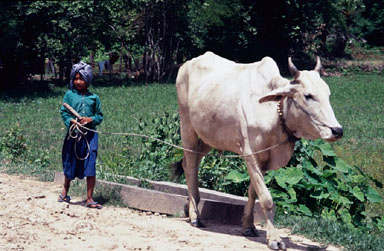Activity 2
Essential Question
- Where did agricultural communities arise and how did their development lead to the rise of complex societies?
Background
The transition to an agrarian lifestyle occurred gradually over a period of thousands of years. Humans did not suddenly decide one day to give up hunting and gathering and begin to farm. Humans had to have a compelling reason to give up a way of life that had worked so well for roughly 32,000 years.

Typical agrarian lifestyle in Southeast Asia
The shift to agriculture began in areas where hunting and gathering could no longer sustain populations because those populations were growing faster than available resources and/or because resources were declining as a result of a changing environment. Oddly, the regions where agriculture first appeared were not in environments that would seem to easily lend themselves to growing crops. Catal Huyuk, Jericho, and other early settlements in Southwest Asia were all located in challenging environments. Other early agrarian communities elsewhere in the world had similarly challenging environments.
Instructional Strategies
Strategy 1 |
Gathering Information: Using Climate Maps as a Source of Information
Have the students visit the following website. Give them sufficient time to investigate the site and try out some of the links.
http://library.humboldt.edu/~rls/geospatial/weathermaps.htm
Use the following questions to establish a purpose for the activity and to guide students to more in-depth information:
- What kind of information do climate maps give us?
- What is this information used for?
- What predictions can we make about how people live based on the information we get from climate maps?
Have the students work in small groups to analyze several of the climate maps. Ask each group to make predictions about areas of the world were favorable to the emergence of early civilizations. Put these predictions on the board or chart paper.
Have students confirm their predictions by reading in their textbooks about the emergence of the first civilizations
- Mesopotamia
- Egypt
- The Indus River Valley
Have them visit this website to find additional information
http://www.pbs.org/wgbh/globalconnections/mideast/themes/geography/
Have the students make a chart summarizing the information they have gathered.
| Area of the World | Climate | Obstacles they had to Overcome |
| Mesopotamia | ||
| Egypt | ||
| The Indus River Valley |
Strategy 2 |
Extending and Refining Information: Concept of Collective Learning
Conduct a demonstration to illustrate the concept of collective learning.
- Select two students from the class to assist with the demonstration.
- Give one a peanut. Explain to the other that she/he must pretend no knowledge of peanuts, not knowing that peanuts are edible or that they must be opened to get the food.
- Tell the student with the peanut that his/her task is to explain the nature of the peanut to the student with no knowledge. The only restriction to the explanation is that it must be done without talking.
- Ask the student with no knowledge to confirm that she/he understood the message conveyed by the first student.
Repeat the demonstration. Again, the student with no knowledge is to pretend to know nothing of peanuts and the explainer must convey the nature of a peanut to the other student without talking. This time, however, do not give the explainer a peanut with which to demonstrate.
Ask the two students to describe how they felt during the demonstration.
- What frustrations did they feel?
- Were you able to communicate?
- Why would the task have been easier if you had been able to communicate orally?
- Are animals able to communicate? Is it easy for them to communicate with us?
Explain the Concept of Collective Learning.
- The ability to communicate through spoken language makes humans unique.
- Humans can describe things that are not present, explain abstract concepts, and discuss the past and future.
- Humans have the ability to share and accumulate knowledge over time. This ability is called collective learning.
- In human communities, if one member of the community comes up with a new idea or invents something useful, all members will learn of it and that knowledge can be passed to later generations.
- The larger the community, the more collective learning will take place, since a larger community will have a larger pool of knowledge, ideas, and experience from which to draw and learn.
Strategy 3 |
Application
Have the students apply what they have learned about early communities by using the concept of collective learning to think about the following questions:
- How did the ability to communicate accelerate the agricultural revolution? What processes would have been impossible without this ability?
- Are you able to compare and contrast this revolution with the technology revolution we are now in the midst of? How is comparing and contrasting an example of the concept of collective learning?
- How is your reading assignment and your website assignment an example of the concept?
Share one new idea you learned about early civilizations with your group. Explain it carefully so that you are sure they understand it and can pass it on to others.
Join your group with another group and talk about what you have learned so far about early civilizations. How is adding more people to the group an example of collective learning?



